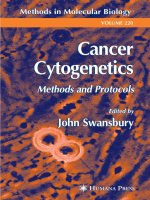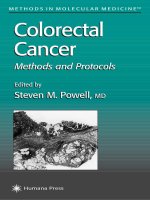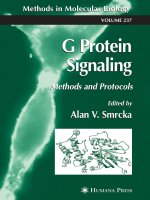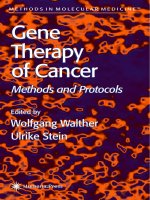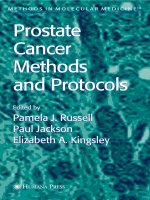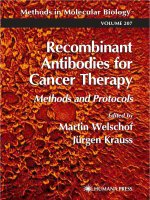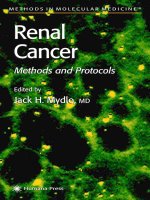cancer cell signaling methods and protocols
Bạn đang xem bản rút gọn của tài liệu. Xem và tải ngay bản đầy đủ của tài liệu tại đây (3.33 MB, 291 trang )
HUMANA PRESS
Methods in Molecular Biology
TM
Edited by
David M. Terrian
Cancer Cell
Signaling
HUMANA PRESS
Methods in Molecular Biology
TM
VOLUME 218
Methods and Protocols
Edited by
David M. Terrian
Cancer Cell
Signaling
Methods and Protocols
Antimitogenic Activity of Tumor Suppression 3
1
Functional Analysis of the Antimitogenic
Activity of Tumor Suppressors
Erik S. Knudsen and Steven P. Angus
3
From:
Methods in Molecular Biology, vol. 218: Cancer Cell Signaling: Methods and Protocols
Edited by: D. M. Terrian © Humana Press Inc., Totowa, NJ
Abstract
Loss of tumor suppressors contributes to numerous cancer types. Many, but
not all, proteins encoded by tumor suppressor genes have antiproliferative activ-
ity and halt cell-cycle progression. In this chapter, we present three methods
that have been utilized to monitor the antimitogenic action exerted by tumor
suppressors. Tumor suppressor function can be demonstrated by colony for-
mation assays and acquisition of the flat-cell phenotype. Because of the anti-
proliferative action of these agents, we also present two transient assays that
monitor the effect of tumor suppressors on cell-cycle progression. One is
based on BrdU incorporation (i.e., DNA replication) and the other on flow
cytometry. Together, this triad of techniques is sufficient to determine the
action of tumor suppressors and other antiproliferative agents.
Key Words: Tumor suppressor; green fluorescent protein; bromo-deoxy-
uridine; retinoblastoma; cell cycle; cyclin; flow cytometry; mitogen; fluo-
rescence microscopy.
1. Introduction
The discovery of tumor suppressor genes, whose loss predisposes to tumor
development, has revolutionized the molecular analysis of cancer (1–3). By def-
inition, tumor suppressor genes are genetically linked to a cancer. For example,
the retinoblastoma (RB) tumor suppressor was first identified as a gene that
was specifically lost in familial RB (4–6). The majority of tumor suppressors
4 Knudsen and Angus
has been identified based on linkage analysis and subsequent epidemiological
studies, however, initial understanding of their mode of action was relatively
limited. As the number of tumor suppressors has increased, understanding the
mechanism through which tumor suppressors function has become an important
aspect of cancer biology.
In general, tumors exhibit uncontrolled proliferation. This phenotype can
arise from loss of tumor suppressors that regulate progression through the cell
cycle (e.g., RB or p16ink4a) or upstream mitogenic signaling (e.g., NF1 or PTEN)
cascades (1,3,7–9). Thus, specific tumor suppressors can function to suppress pro-
liferation. However, not all tumor suppressors act in this manner. For example,
mismatch repair factors (e.g., MSH2 or MLH-1) lost in hereditary nonpolyposis
colorectal cancer (HNPCC) function not to inhibit proliferation, but to prevent
further mutations (10–12). Additionally, other tumor suppressors have multi-
ple functions, for example, p53 can function to either induce cell death or halt
cell-cycle progression (9,13).
Functional analysis of tumor suppressors relies on a host of methods to deter-
mine how or if they inhibit proliferation. Later, we will focus on methods that
have been used to assess the antimitogenic potential of the RB-pathway (2,3,7,
14). However, these same approaches are amenable to any tumor suppressor or
antimitogenic molecule.
Assays used to evaluate antimitogenic activity are based either on the halt of
proliferation or cell-cycle progression. Cell proliferation assays, as described
later, have been extensively utilized to demonstrate the antiproliferative effect
of tumor suppressors (15–20). However, these assays do not illuminate whether
the observed effects are attributable to cell-cycle arrest or apoptosis. Addition-
ally, because of the antiproliferative action of many tumor suppressors, it is
difficult to obtain sufficient populations of cells for analysis. This obstacle can
be surmounted through the use of transient assays to monitor cell-cycle effects
(16,19,21–25). Two different transient approaches to analyze tumor suppressor
action on the cell cycle are also described.
2. Materials
2.1. Cell Culture and Transfection
of Antimitogen/Tumor Suppressor
1. SAOS-2 human osteosarcoma cell line (ATCC #HTB-85).
2. Dulbecco’s modification of Eagle’s medium (DMEM, Cellgro, cat #10-017-CV)
supplemented with 10% heat-inactivated fetal bovine serum (FBS, Atlanta Bio-
logicals, cat #S12450), 100 U/mL penicillin-streptomycin and 2 mM L-glutamine
(Gibco-BRL).
Antimitogenic Activity of Tumor Suppression 5
3. Dulbecco’s phosphate-buffered saline (PBS), tissue culture grade, without calcium
and magnesium (Cellgro, cat #21-031-CV).
4. 1X Trypsin-EDTA solution (Cellgro, cat #25-052-CI).
5. 60-mm tissue-culture dishes.
6. Six-well tissue-culture dishes.
7. 12-mm circular glass cover slips (Fisher), sterilized.
8. Mammalian expression system (e.g., pcDNA3.1, Invitrogen).
9. Relevant cDNAs: RB, Histone 2B (H2B)-GFP [from G. Wahl, The Salk Institute,
La Jolla, CA (26)], pBABE-puro [puromycin resistance plasmid, (27)].
10. 0.25M CaCl
2
: dissolve in ddH
2
O; filter (0.2 µm) sterilize and store in aliquots at
−20ºC.
11. 2X BES-buffered solution (2X BBS): 50 mM N,N-bis (2-hydroxyethyl)-2-amino-
ethanesulfonic acid, 280 mM NaCl, 1.5 mM Na
2
HPO
4
, adjust pH to 6.95 in ddH
2
O,
filter (0.2 µm) sterilize and store in aliquots at −20ºC.
12. Inverted fluorescence microscope (Zeiss).
2.2. Inhibition of BrdU
Incorporation in Transiently-Transfected Cells
1. Transfected SAOS-2 cells.
2. Cell proliferation-labeling reagent, BrdU/FdU (Amersham Pharmacia, cat# RPN201).
3. PBS: 136 mM NaCl, 2.6 mM KCl, 10mM Na
2
HPO
4
, 2.7 mM KH
2
PO
4
in ddH
2
O;
pH to 7.4 with HCl; sterilize in autoclave.
4. 3.7% (v/v) formaldehyde in PBS: dilute fresh from 37% w/w stock solution (Fisher).
5. 0.3% (v/v) Triton X-100 (Fisher) in PBS.
6. Immunofluorescence (IF) buffer: 0.5% v/v Nonidet P-40 (Fisher) and 5 mg/mL
(w/v) bovine serum albumin (Sigma) in PBS; store at 4ºC.
7. 1M MgCl
2
.
8. DNase I, RNase-free (10 U/µL) (Roche, cat# 776 785).
9. Monoclonal rat anti-BrdU antibody (Accurate Scientific, cat #YSRTOBT-0030).
10. Donkey anti-rat IgG, Red X-conjugated (Jackson Immunoresearch, cat #712-295-
153).
11. 1 mg/mL (w/v) Hoechst 33258 (Sigma, cat #B2883).
12. Microscope slides.
13. Gel/Mount (Biomeda Corp., cat #MØ1)
14. Inverted fluorescence microscope (Zeiss).
2.3. Cell-Cycle Analysis of Transiently-Transfected Cells
1. Transfected SAOS-2 cells.
2. PBS.
3. 1X Trypsin-ethylene diamine tetraacetic acid (EDTA) solution (Cellgro, cat #25-
052-CI).
4. Clinical centrifuge.
6 Knudsen and Angus
5. 100% ethanol stored at −20ºC.
6. 40 mg/mL (w/v) RNase A (Sigma, cat #R-4875): Dissolve in sterile double-dis-
tilled (dd)H
2
O at 100ºC, 15 min; aliquot and store at −20ºC.
7. 100X propidium iodide (PI) solution: 20 mg/mL (w/v) propidium iodide (Sigma,
cat #P-4170) in PBS; cover with foil to protect from light and store at 4ºC.
8. 5-mL polystyrene round-bottom tubes (Becton Dickinson, cat #35-2058).
9. Coulter Epics XL flow cytometer.
10. FlowJo data analysis software (Treestar).
11. ModFit cell-cycle analysis software (Verity).
2.4. Flat-Cell Assay and Colony
Inhibition in Stably-Transfected Cells
1. Transfected SAOS-2 cells.
2. 2.5 mg/mL puromycin (w/v) (Sigma, cat #P-7255).
3. 1% crystal violet (w/v) (Fisher, cat #C581-25)/20% ethanol solution.
4. Inverted microscope with camera.
3. Methods
3.1. Cell Culture and Transfection
of Antimitogen/Tumor Suppressor
3.1.1. Cell Culture
1. Seed approx 1 × 10
5
cells per well of a six-well plate or 3 × 10
5
cells per 60-mm
dish in DMEM supplemented with 10% FBS and penicillin-streptomycin.
2. SAOS-2 cells should attach to the tissue culture dish within 4–6 h.
3.1.2. Cell Transfection
1. Prepare purified plasmid DNA stocks at 1 mg/mL concentration in TE buffer.
2. Add DNA to 1.5-mL Eppendorf tube (4.25 µg per well of a six-well plate, 8.5 µg
total per 60-mm dish).
3. Add 0.25M CaCl
2
to DNA and mix by pipeting.
4. Add 2X BBS solution and mix by inverting.
5. Incubate tubes at room temperature for 20 min.
6. Add DNA/CaCl
2
/BBS solution to cells dropwise.
7. Inspect the cells for the presence of precipitate using an inverted microscope (20×
power is sufficient) (see Note 1).
8. Return cells to tissue culture incubator (37ºC, 5% CO
2
).
9. 16 h postaddition of precipitate, wash cells three times briefly with PBS.
10. Inspect dishes to ensure removal of precipitate.
11. Add fresh media to cells.
Antimitogenic Activity of Tumor Suppression 7
3.1.3. Confirmation of Transfection/
Determining Transfection Efficiency
1. Take live plates of cells transfected 16 h prior with H2B-GFP and either vector or
antimitogen/tumor suppressor out of the incubator.
2. Aspirate media.
3. Replace with PBS.
4. Visualize transfected cells by GFP fluorescence using an inverted fluorescent micro-
scope (20X power is sufficient).
5. Using the GFP fluorescence and phase contrast, determine the percentage of GFP-
positive cells by counting random fields of cells.
6. Compare the relative transfection efficiencies between vector control and antimito-
gen/tumor suppressor.
3.2. Inhibition of BrdU
Incorporation in Transiently Transfected Cells
3.2.1. Cell Culture
1. Culture cells at 60% confluence (approx 1 × 10
5
cells/well) on coverslips in a six-
well plate (four cover slips per well).
3.2.2. Cell Transfection
1. Use 4 µg of CMV-vector or CMV-RB and 0.25 µg of CMV-H2B-GFP.
2. Use 0.125 mL CaCl
2
and 0.125 mL 2X BBS.
3.2.3. BrdU Labeling
1. 36–48 h after adding fresh media to transfected cells, add cell proliferation-label-
ing reagent directly to media in wells (1:1000 dilution) (see Note 2).
2. Return six-well dish to tissue-culture incubator for 16 h.
3.2.4. Fixation
1. Aspirate media from wells.
2. Wash cells gently with PBS.
3. Fix cells at room temperature with 3.7% formaldehyde in PBS for 15 min.
4. Aspirate formaldehyde.
5. Add PBS to wells.
6. Cover slips in PBS may be stored in dark at 4ºC.
3.2.5. BrdU Staining
1. Aspirate PBS.
2. Add 0.3% Triton X-100 in PBS to wells to permeabilize the cells (see Note 3).
3. Incubate dish at room temperature for 15 min.
4. Aspirate 0.3% Triton X-100 and replace with PBS.
8 Knudsen and Angus
5. Prepare primary antibody solution by diluting the following in IF buffer:
a. 1:50 1M MgCl
2
.
b. 1:500 Rat anti-BrdU.
c. 1:500 DNase I (see Note 4).
6. Pipet 35 µL primary antibody solution onto each cover slip.
7. Incubate cover slips in a humidified chamber at 37ºC for 45 min (see Fig. 1).
8. Wash cover slips in PBS in six-well dish for 5 min with 2–3 changes.
9. Prepare secondary antibody solution by diluting the following in IF buffer:
a. 1:100 Donkey anti-rat Red-X.
b. 1:100 Hoechst (10 µg/mL final conc.).
10. Pipet 35 µL secondary antibody solution onto each cover slip.
11. Incubate cover slips in humidified chamber at 37ºC for 45 min.
12. Wash cover slips in PBS in six-well dish for 5 min with 2–3 changes.
13. Mount cover slips on slides using Gel/Mount.
14. Examine cover slips using an inverted fluorescence microscope.
15. Inhibition determined by counting.
Fig. 1. Diagram of BrdU staining in a humidified chamber of fixed and permeabil-
ized cells grown on glass cover slips.
Antimitogenic Activity of Tumor Suppression 9
3.2.6. Quantitation and Documentation
1. Quantitation of BrdU inhibition.
a. Count the number of transfected (i.e., GFP-positive) cells in a random field).
b. Without changing fields, count the number of GFP-positive cells that are also
BrdU-positive (i.e., Red-X-positive).
c. Repeat steps a and b until 150–200 GFP-positive cells have been counted.
d. Calculate the percent BrdU-positive (BrdU-positive/GFP-positive).
e. As a control, determine the percentage of BrdU-positive cells from
untransfected (GFP-negative) cells on the same cover slips.
f. Compare the effect of antimitogen expression vs vector expression on BrdU incor-
poration (see Fig. 2).
2. Documentation
a. Take representative photomicrographs of selected fields.
b. Use blue (Hoechst), green (H2B-GFP), and red (Red-X) channels to obtain
photomicrographs of the same field.
3.3. Cell-Cycle Arrest in Transiently-Transfected Cells
3.3.1. Cell Culture
1. Culture cells in 60-mm dishes at 60% confluence.
2. Include a dish that will not be transfected.
3.3.2. Cell Transfection
1. Use 8 µg of CMV-vector or CMV-RB and 0.5 µg of CMV-H2B-GFP (see Note 5).
2. Use 0.25 mL CaCl
2
and 0.25 mL 2X BBS.
Fig. 2. SAOS-2 cells were cotransfected with H2B-GFP and either CMV-vector or
CMV-RB. Cells were pulse-labeled with BrdU for 16 h. Fixation, permeabilization,
and immunostaining were performed as described. Photomicrographs of immunofluo-
rescent cells were taken at equal magnification. Arrows indicate transfected cells. Quanti-
fication of this approach is presented in refs. (19,21–23).
10 Knudsen and Angus
3.3.3. Cell Harvesting and Fixation
1. 36–48 h after adding fresh media to transfected cells, add trysin (approx 0.75 mL)
to dishes.
2. Confirm that cells have detached after 1–2 min using inverted microscope.
3. Inactivate trypsin by adding an equal volume of media.
4. Transfer suspended cells to 15-mL conical tubes.
5. Pellet cells in a clinical centrifuge at 1000 rpm, 2–3 min.
6. Aspirate media.
7. Add 2–3 mL PBS to wash cell pellet.
8. Repeat centrifugation.
9. Aspirate PBS.
10. Resuspend cell pellet in 200 µL PBS.
11. Slowly add 1 mL ice-cold 100% ethanol while vortexing gently.
12. Tubes may be stored in the dark at 4ºC for 1–2 wk.
3.3.4. Propidium Iodide Staining
1. Prepare 1X PI by diluting 100X PI stock solution in PBS (see Note 6).
2. Add RNase A to 1X PI at a 1:1000 dilution (final concentration = 40 µg/mL).
3. Pellet fixed cells at 200g, 2–3 min.
4. Aspirate ethanol.
5. Resuspend cell pellet in approx 1 mL 1X PI containing RNase A.
6. Transfer resuspended cells to 5-mL polystyrene round-bottom tubes.
7. Incubate tubes in the dark at room temperature for at least 15 min prior to analysis
(see Note 7).
3.3.5. FACS
1. Run untransfected control to set background levels of GFP signal and to establish
PI parameters.
2. Gate H2B-GFP-positive cells (either positive or negative) (see Fig. 3 and Note 8).
3. Analyze PI staining in GFP-positive cells.
4. Perform ModFit analysis on PI histograms (see Fig. 3).
3.4. Flat-Cell Assay/Colony
Inhibition in Stably Transfected Cells
3.4.1. Cell Culture
1. Culture 1 × 10
5
cells in 60-mm dishes.
2. Include a control plate that will not be transfected.
3.4.2. Cell Transfection
1. Use 8 µg of CMV-vector or CMV-RB and 0.5 µg of pBABE-puro.
2. Use 0.25 mL CaCl
2
and 0.25 mL 2X BBS.
Antimitogenic Activity of Tumor Suppression 11
3.4.3. Puromycin Selection and Staining
1. 24 h after adding fresh media to transfected cells, add puromycin to media at a
1:1000 dilution (final concentration = 2.5 µg/mL puromycin).
2. Confirm puromycin selection by visual analysis of untransfected cells.
Fig. 3. SAOS-2 cells either untransfected (left column) or transfected with H2B-GFP
and either CMV-vector (middle column), or RB (right column) were fixed in ethanol
and stained with propidium iodide (PI). Cells were subsequently analyzed by FACS.
Top row, Cells were gated to distinguish the GFP-negative population from the GFP-
positive population. Hatched line indicates gate position (GFP-positive cells above line,
GFP-negative cells below). Middle row, GFP-negative cells were analyzed for DNA
content (PI) and ModFit analysis was performed to quantitate cell cycle distribution (%
phase) as indicated. Bottom row, GFP-positive cells were analyzed for DNA content
(PI) and ModFit analysis was performed to quantitate cell cycle distribution (% phase)
as indicated.
12 Knudsen and Angus
3. Monitor selection/cell death daily by visual analysis using an inverted microscope
(see Fig. 4).
4. Plates for flat-cell analysis should be stained 5–8 d postselection.
5. Plates for colony inhibition should be analyzed 8–14 d postselection.
3.4.4. Crystal Violet Staining
1. Aspirate media.
2. Wash plates twice with PBS.
3. Add 5 mL 1% crystal violet/20% ethanol solution to cell plates.
4. Incubate plates at room temperature 5 min.
5. Immerse plates in ice-cold water bath.
6. Rinse until no more crystal violet is washing into the water.
7. Invert plates on paper towels and dry at room temperature.
8. Dried plates will store for greater than 1 yr kept in the dark.
3.4.5. Quantitation and Documentation
1. Flat-cell phenotype
a. Using a microscope with a grid of known unit area, count flat cells present in
multiple random fields.
b. To document results, take low-magnification (×10 or ×20) pictures of the flat
cells (see Fig. 4).
2. Colony inhibition
a. Count all visible colonies on plate or in a specific unit area of the plate.
b. To document results, take a picture of the entire plate (no magnification required).
Fig. 4. SAOS-2 cells transfected as described with pBABE-puro and either (A) CMV-
vector or (B) RB were selected with 2.5 µg/mL puromycin for 4 d. Note the flat-cell
phenotype exhibited by the RB-transfected cell. Phase-contrast photomicrographs are
of equal magnification. Quantitation of this approach and colony outgrowth is published
in refs. (15–17,19 ,20,25).
Antimitogenic Activity of Tumor Suppression 13
4. Notes
1. The formation/presence of black, granular precipitate ensures the quality of the
transfection reagents (i.e., 0.25M CaCl
2
and 2X BBS). Poor precipitate formation
is often due to incorrect pH of the 2X BBS solution.
2. BrdU is light sensitive. Add to tissue-culture dishes in the dark, and limit light expo-
sure (as with fluorophores) during staining.
3. We typically permeabilize and stain only one or two of the fixed coverslips from
each well, in case of errors during staining.
4. We recommend using DNase I only from Roche. DNase I purchased from other
companies has produced poor results, likely because of excess enzyme activity.
5. Cotransfection with H2B-GFP fusion protein (as opposed to GFP alone) to distin-
guish transfected cells is essential particularly for FACS anaylsis. The use of etha-
nol to fix cells for propidium iodide staining results in the loss of soluble protein.
However, other markers (e.g., CD20; see ref. (25)) that provide green fluorescent
signal for sorting may be used.
6. Propidium iodide is light sensitive. Stock solution and resuspended cells in 1X PI
should be protected from light with foil.
7. Adequate incubation time to allow complete RNase digestion is critical for inter-
pretable results.
8. The percentage of GFP-positive cells determined by FACS analysis should be approx-
imately equal to the percentage determined by visual inspection prior to harvesting.
Acknowledgments
The authors would like to thank Dr. Karen Knudsen for helpful suggestions
and critical reading of the manuscript. We are also grateful to Dr. Geoff Wahl
(The Salk Institute, La Jolla, CA) for providing H2B-GFP expression plasmid.
We also wish to thank Dr. George Babcock and Sandy Schwemberger (Shriners
Hospital for Children, Cincinnati, OH) for expert flow cytometric analysis.
References
1. Knudson, A. G. (1993) Antioncogenes and human cancer. Proc. Natl. Acad. Sci.
USA 90, 10,914–10,921.
2. Weinberg, R. A. (1995) The retinoblastoma protein and cell cycle control. Cell
81, 323–30.
3. Macleod, K. (2000) Tumor suppressor genes. Curr. Opin. Genet. Dev. 10, 81–93.
4. Cavenee, W. K., Dryja, T. P., Phillips, R. A., Benedict, W. F., Godbout, R., Gallie,
B. L., et al. (1983) Expression of recessive alleles by chromosomal mechanisms
in retinoblastoma. Nature 305, 779–784.
5. Friend, S. H., Bernards, R., Rogelj, S., Weinberg, R. A., Rapaport, J. M., Albert,
D. M., and Dryja, T. P. (1986) A human DNA segment with properties of the gene
that predisposes to retinoblastoma and osteosarcoma. Nature 323, 643–646.
14 Knudsen and Angus
6. Lee, W. H., Bookstein, R., Hong, F., Young, L. J., Shew, J. Y., and Lee, E. Y. (1987)
Human retinoblastoma susceptibility gene: cloning, identification, and sequence.
Science 235, 1394–1329.
7. Sherr, C. J. (1996) Cancer cell cycles. Science 274, 1672–1677.
8. Hanahan, D. and Weinberg, R. A. (2000) The hallmarks of cancer. Cell 100, 57–70.
9. Evan, G. I. and Vousden, K. H. (2001) Proliferation, cell cycle and apoptosis in can-
cer. Nature 411, 342–348.
10. Peltomaki, P. (2001) Deficient DNA mismatch repair: a common etiologic factor
for colon cancer. Hum. Mol. Genet. 10, 735–740.
11. Kolodner, R. D. (1995) Mismatch repair: mechanisms and relationship to cancer
susceptibility. Trends Biochem. Sci. 20, 397–401.
12. Kinzler, K. W. and Vogelstein, B. (1996) Lessons from hereditary colorectal can-
cer. Cell 87, 159–170.
13. Levine, A. J. (1997) p53, the cellular gatekeeper for growth and division. Cell 88,
323–331.
14.Wang, J. Y., Knudsen, E. S., and Welch, P. J. (1994) The retinoblastoma tumor sup-
pressor protein. Adv. Cancer Res. 64, 25–85.
15. Arap, W., Knudsen, E., Sewell, D. A., Sidransky, D., Wang, J. Y., Huang, H. J.,
and Cavenee, W. K. (1997) Functional analysis of wild-type and malignant glioma
derived CDKN2Abeta alleles: evidence for an RB-independent growth suppres-
sive pathway. Oncogene 15, 2013–2020.
16.Arap, W., Knudsen, E. S., Wang, J. Y., Cavenee, W. K., and Huang, H. J. (1997) Point
mutations can inactivate in vitro and in vivo activities of p16(INK4a)/CDKN2A
in human glioma. Oncogene 14, 603–609.
17.Hinds, P. W., Mittnacht, S., Dulic, V., Arnold, A., Reed, S. I., and Weinberg, R. A.
(1992) Regulation of retinoblastoma protein functions by ectopic expression of
human cyclins. Cell 70, 993–1006.
18. Templeton, D. J., Park, S. H., Lanier, L., and Weinberg, R. A. (1991) Nonfunc-
tional mutants of the retinoblastoma protein are characterized by defects in phos-
phorylation, viral oncoprotein association, and nuclear tethering. Proc. Natl. Acad.
Sci. USA 88, 3033–3037.
19. Knudsen, K. E., Weber, E., Arden, K. C., Cavenee, W. K., Feramisco, J. R., and
Knudsen, E. S. (1999) The retinoblastoma tumor suppressor inhibits cellular pro-
liferation through two distinct mechanisms: inhibition of cell cycle progression
and induction of cell death. Oncogene 18, 5239–45.
20. Qin, X. Q., Chittenden, T., Livingston, D. M., and Kaelin, W. G. Jr. (1992) Iden-
tification of a growth suppression domain within the retinoblastoma gene prod-
uct. Genes Dev. 6, 953–964.
21. Knudsen, E. S., Pazzagli, C., Born, T. L., Bertolaet, B. L., Knudsen, K. E., Arden,
K. C., et al. (1998) Elevated cyclins and cyclin-dependent kinase activity in the
rhabdomyosarcoma cell line RD. Cancer Res. 58, 2042–2049.
22. Knudsen, E. S., Buckmaster, C., Chen, T. T., Feramisco, J. R., and Wang, J. Y.
(1998) Inhibition of DNA synthesis by RB: effects on G1/S transition and S-phase
progression. Genes Dev. 12, 2278–2292.
Antimitogenic Activity of Tumor Suppression 15
23. Knudsen, K. E., Fribourg, A. F., Strobeck, M. W., Blanchard, J. M., and Knudsen,
E. S. (1999) Cyclin A is a functional target of retinoblastoma tumor suppressor
protein-mediated cell cycle arrest. J. Biol. Chem. 274, 27,632–27,641.
24.Agami, R. and Bernards, R. (2000) Distinct initiation and maintenance mechanisms
cooperate to induce G1 cell cycle arrest in response to DNA damage. Cell 102, 55–66.
25. Zhu, L., van den Heuvel, S., Helin, K., Fattaey, A., Ewen, M., Livingston, D., et al.
(1993) Inhibition of cell proliferation by p107, a relative of the retinoblastoma
protein. Genes Dev. 7, 1111–1125.
26. Kanda, T., Sullivan, K. F., and Wahl, G. M. (1998) Histone-GFP fusion protein
enables sensitive analysis of chromosome dynamics in living mammalian cells.
Curr. Biol. 8, 377–385.
27. Morgenstern, J. P. and Land, H. (1990) Advanced mammalian gene transfer: high
titre retroviral vectors with multiple drug selection markers and a complementary
helper-free packaging cell line. Nucleic Acids Res. 18, 3587-3596.
Gene-Targeted ES Cells 35
3
Signal Transduction Study
Using Gene-Targeted Embryonic Stem Cells
Hideki Kawasome, Takashi Hamazaki, Tetsuo Minamino,
and Naohiro Terada
35
From:
Methods in Molecular Biology, vol. 218: Cancer Cell Signaling: Methods and Protocols
Edited by: D. M. Terrian © Humana Press Inc., Totowa, NJ
Abstract
Gene targeting is one of the most powerful tools to define the role of sig-
naling molecules in animal development and disease etiology. By using this
technique, nearly 1000 knockout mice have been produced over the last two
decades. Generating knockout mice, however, is a time-consuming procedure.
Also, an unexpected embryonic lethality sometimes prevents us from examin-
ing the function of the gene in specific tissues. Here, we describe a convenient
method to directly disrupt genes at both alleles in murine embryonic stem (ES)
cells. These homozygous knockout ES cells have been shown useful to deter-
mine the role of the genes in the mediation of various cellular activities such
as proliferation, differentiation, apoptosis, survival, transformation, and so on.
Furthermore, with the recent advance of in vitro differentiation techniques,
it is now feasible to rapidly determine the role of specific molecules in partic-
ular tissues.
Key Words: Gene targeting; embryonic stem cells; homologous recombina-
tion; homozygous knockout; heterozygous knockout; in vitro differentia-
tion; signal transduction; p70 S6 kinase; mitogen activated protein kinase.
1. Introduction
1.1. Homozygously Gene-Targeted Embryonic Stem Cells
Embryonic stem (ES) cells are continuously growing stem cell lines of embry-
onic origin first isolated from the inner cell mass of blastocysts (1,2). The dis-
tinguishing features of ES cells in mice are their capacity to be indefinitely
36 Kawasome et al.
maintained in an undifferentiated state in culture and their potential to develop
into every cell type, including germ line, when they are injected into mouse
blastocysts (3). Furthermore, chromosomes of ES cells are fairly stable, and
homologous recombination commonly occurs between genome and introduced
compatible sequences (4). By using these unique features of ES cells, gene-
targeting techniques have been developed, and a great number of knockout mice
have been produced in the last two decades. These gene disruption studies are
constructing persuaded frameworks of numerous signaling molecules, which
are involved in the mediation of cellular activities such as proliferation, differen-
tiation, apoptosis, survival, and transformation. Here, we describe a convenient
method to directly disrupt genes at both alleles in murine ES cells to determine
the role of the targeted genes in ES cells (see Fig. 1). Using this method, we
homozygously disrupted the p70 S6 kinase (p70
s6k
, S6K1) gene in murine embry-
onic stem cells to determine the role of the kinase in cell growth, protein syn-
thesis, and rapamycin sensitivity (5).
Fig. 1. Overview of the gene-targeting strategy. Generation of homozygous knock-
out ES cells allows us to analyze the role of the targeted molecules in vitro without mak-
ing knockout mice. Furthermore, we are able to investigate the function of the genes
in specific cell types rapidly in combination with in vitro differentiation techniques of
ES cells.
Gene-Targeted ES Cells 37
1.2. In Vitro ES Cell Differentiation
In addition to their pluripotent ability to differentiate in vivo, ES cells can
also differentiate into multiple cell lineages in vitro as well. The in vitro differ-
entiation of ES cells is induced by removing the mouse embryonic fibroblast
(MEF) feeder layer or leukemia inhibitory factor (LIF) from the ES cell culture,
and usually by allowing them to form aggregates in suspension. ES cells aggre-
gate into structures termed embryoid bodies (EB), in which all three germ layers
develop and interact with each other. Well-differentiated EBs are composed of
multiple differentiated cell types including neuronal, cardiac muscle, hemato-
poietic, and chondrocytic cells. EBs recapitulate many processes that take place
during normal embryonic development (6). Certain aspects of the kinetics of lin-
eage development observed within EBs show remarkable similarities to those
observed in the developing embryo (7). Further, many researchers have been
developing the techniques to isolate a specific cell type from differentiating ES
cells in vitro. Combined with the homozygous gene-targeting described earlier
and in vitro differentiation techniques, it is now feasible to rapidly determine
the role of a specific molecule in specific tissues (8–14). We demonstrated the
usefulness of this in vitro ES differentiation system combined with targeted
gene disruption to define complex regulatory events in a cardiac disease model
(15). Using cardiac myocytes derived from MEKK1 null ES cells in vitro (16),
we successfully demonstrated a role of mitogen-activated protein kinases in myo-
cardial injury by oxidative stress. This in vitro method is particularly useful when
gene disruption causes embryonic lethality. We were able to analyze the role of
SEK1 in late hepatic maturation using this method (17), despite the embryonic
lethality of SEK1 knockout mice.
Finally, these in vitro approaches would be very useful with human ES cells
(18,19), where in vivo knockout study is not allowed.
2. Materials
2.1. Mouse ES Cells and Maintenance (20)
ES cells (R1) were maintained on feeder cells (STO cells or Mouse Embryonic
Fibroblast). They were also cultured on gelatinized plates instead of feeder cells
for a short period, particularly when we needed pure ES cells without feeder
cells for biochemical analysis etc (see Note 1).
2.1.1. Cells
R1 cells and STO cells were kindly provided by Dr. A. Nagy (Mt. Sinai Hospi-
tal, Toronto) and Dr. G. M. Keller (Mt. Sinai School of Medicine, NY). This STO
cell line was genetically manipulated and resistant to G418 for antibiotic screen-
ing of ES cells.
38 Kawasome et al.
2.1.2. ES Cell Medium
1. D-MEM high glucose (Gibco, 11995-073), 425 mL.
2. Fetal calf serum (FCS, heat inactivated; check lot for the ability to maintain ES
cells undifferentiated), 75 mL (see Note 2).
3. Monothioglycerol (Sigma, M-6145), 1:10 dilution, buy every 3 mo, 62 µL.
4. Penicillin-streptomycin, liquid (Gibco, 15070-063), 5 mL.
5. LIF (Chemicon, ESG1107), 50 µL.
6. HEPES buffer solution (1 M) (Gibco, 15630-106), 12.5 mL.
2.1.3. Trypsin/EDTA
1. Trypsin 1:250 (Sigma T-4799), 1.25 g.
2. 0.5 M ethylenediamine tetraacetic acid (EDTA), 1.05 mL.
3. PBS(-), 500 mL (see Note 3).
2.1.4. Gelatin
1. Add 0.5 g of gelatin (Sigma G1890) in 500 mL PBS(-), autoclave, and keep at 4ºC.
2. Cover the culture plates with gelatin solution for 20 min at room temperature and
remove it before plating STO or ES cells.
2.1.5. STO Cell Culture
1. Culture STO cells in ES cell medium without LIF in gelatinized flask.
2. Treat confluent STO cells with 6000–10,000 rads of gamma irradiation before plat-
ing ES cells (see Note 4).
2.1.6. 2X Cell Stock Solution
1. 20% dimethyl sulfoxide (DMSO).
2. 80% FCS.
2.1.7. Prepare ES Cells From a Frozen Stock
1. Thaw cells at 37ºC and wash once with medium.
2. Add 5 mL of medium and pipeting.
3. Transfer cells into T-25 flask with feeder cells and culture at 37ºC, 5% CO
2
.
4. Change medium at d 1 or d 2 and passage at d 3.
2.1.8. Passage of ES Cells
1. Discard medium and wash once with 5 mL of PBS(-).
2. Add 0.5 mL of Trypsin/EDTA and sit for 2–3 min at room temperature.
3. Tap the flask to remove cells.
4. Add 5 mL of medium and pipeting.
5. Transfer cells into T-75 flask with feeder cells and add medium to 15 mL.
6. Change medium at d 1 or d 2 and passage at d 3.
Gene-Targeted ES Cells 39
2.2. Targeting Vectors
2.2.1. Cloning of Genomic DNA Coding a Target Gene
A genomic DNA coding the gene of interest for constructing a targeting vec-
tor is needed. A genomic library from the same strain of mice with the ES cells
should be used. Plaque hybridization was performed to get a genomic DNA in
this section (see Note 5).
1. Library: 129SV Mouse Genomic Library in the Lambda FIXII Vector was pur-
chased from Stratagene and screening was performed following manufacture’s proto-
col (Stratagene, La Jolla, CA).
2. Screening:
a. Prepare 10 plates with about 50,000 plaques of genomic library per 150-mm plate.
b. Refrigerate the plates for 2 h at 4ºC.
c. Put nylon filters on the plates to lift plaques for 2 min, denature in 1.5 M NaCl,
0.5 M NaOH for 2 min, neutralize in 1.5 M NaCl, 0.5 M Tris-HCl pH 8.0 for
5 min, and rinse in 0.2 M Tris-HCl pH 7.5, 2X SSC (20X SSC: 3 M NaCl, 0.3 M
sodium citrate, pH 7.0).
d. Crosslink DNA to the filters for 30 s using auto-crosslink setting on the Strata-
linker UV crosslinker (Stratagene).
e. Prehybridize the filters in 2X PIPES, 50% formamide, 0.5% sodium dodecyl
sulfate (SDS), and 100 µg/mL of denatured and sonicated salmon sperm DNA
for 2 h at 42ºC.
f. Label the probe and hybridize to the filters in 2X PIPES, 50% formamide, 0.5%
sodium dodecyl sulfate (SDS), and 100 µg/mL of denatured and sonicated salmon
sperm DNA overnight at 42ºC.
g. Wash the filters in 0.1X SSC, 0.1% SDS at 60ºC, and expose to X-ray film over-
night at −70ºC.
2.2.2. Construction of a Targeting Vector
1. Analysis of Genomic DNA
a. Digest a cloned genomic DNA with several restriction enzymes and prepare restric-
tion map.
b. Hybridize cDNA probe to each digested fragment for determining the position
of exons. Confirm the exons by sequencing.
2. Construction of a targeting vector (21).
Figure 2 illustrates a targeting vector we made when we disrupted p70 S6
kinase gene (5). A neomycin resistance gene was inserted to disrupt one exon,
shown in Fig. 2B. HSV thymidine kinase (HSVtk) gene was inserted for nega-
tive selection. When homologous recombination has occurred (see Fig. 2C),
the cells become resistant to G418 and Gancyclovir. Arrowheads indicate prim-
ers for screening by polymerase chain reaction (PCR). If the cells have a knock-
out allele, the Neo1 and PS1 primer set can amplify a DNA fragment. If the cells
40 Kawasome et al.
have a wild-type allele, the AH and PS1 primer set can amplify a DNA frag-
ment. The genotype can be determined using both sets of primers. Note that the
position of the primer PS1 is out of the targeting vector. This is important for
detecting a homologous recombination from random inserting. We designed
the vector having one short arm for PCR screening. The probe in Fig. 2A was
used for Southern blot. After the digestion with EcoRI and PstI, the wild-type
allele shows 2670 bp band and the knockout allele shows 2430 bp.
3. Methods
3.1. Heterozygous Gene Targeting
3.1.1. Transfection of a Targeting Vector
1. Trypsinize ES cells to single cells, add medium, and incubate on culture dishes
for 15 min to let feeder cells attach to the dishes.
2. Transfer the suspended cells to new tubes, wash, and resuspend in PBS(-).
3. Mix 0.8 mL of the cell suspension (1 × 10
7
cells) with 30 µg of linearized vector
DNA, and transfer into an electroporation cuvet.
Fig. 2. Structure of the genome coding p70 S6 kinase and targeting vector. (A)
Genome encoding p70 S6 kinase. (B) Targeting vector. (C) Expected structure of the
genome after homologous recombination.
Gene-Targeted ES Cells 41
4. Deliver the electric pulse by BioRad Gene Pulser at 230 V, 500 µF. Place the cuvet
at room temperature for 20 min. (Try several different conditions to obtain maxi-
mum efficiency. We performed 180, 230, 240, 250, and 300 V and obtained the
most number of colonies with 230 V.)
5. Plate the cells to three 100-mm dishes and incubate at 37ºC, 5% CO
2
.
6. Add G418 at 500 µg/mL and gancyclovir at 4 µM for drug selection in 2 d after
the electroporation.
7. Culture the cells for about 12 d by changing media every other day.
3.1.2. Making a Stock
of Each Colony and DNA Extraction for Analysis
1. Pick up the G418 and gancyclovir-resistant colonies with a pipet (P-20 tip with
filter) under an inverted microscope. Transfer a colony into a 96-well round-bottom
plate with 50 µL/well of trypsin/EDTA and incubate for 10 min at 37ºC. Pipet the
cells and transfer to a 24-well plate with feeder cells and 1 mL of medium.
2. After the cells have grown to 50% confluence, wash once with PBS(-) and incu-
bate with 100 µL of trypsin/EDTA for 5 min at 37ºC.
3. Add 750 µL of medium and pipet gently for breaking the clumps.
4. Transfer 250 µL of cell suspension to a new gelatin-coated 24-well plate for DNA
analysis.
5. Mix remaining 500 µL of cell suspension with 500 µL of 2X cell stock solution.
Freeze at −20ºC for 15 min, at −80ºC overnight, and keep in liquid nitrogen afterward.
6. After the cells for DNA analysis have grown to 50% confluence, wash once with
PBS(-), and incubate overnight at 37ºC with 500 µL of a lysis buffer containing
10 mM Tris-HCl (pH 8.0), 25 mM EDTA (pH 8.0), 0.5% SDS, 75 mM NaCl, and
100 µg/mL proteinase K.
7. Extract DNA by phenol/chloroform, precipitate in ethanol, and dissolve in 100 µL
of water.
3.1.3. Screening by PCR
1. PCR mixture contains 250 nM of each primer, Neo1 or AH and PS1 (see Fig. 2),
200 µM of each deoxynucleotide triphosphate, 50 mM KCl, 10 mM Tris-HCl, pH
8.3, 1.5 mM magnesium acetate, 1.25 unit of Taq DNA polymerase, and 5 µL of
template DNA in total volume of 50 µL.
2. PCR conditions include an initial incubation at 94ºC for 2 min followed by 35
cycles of 1 min at 94ºC, 1 min at 55ºC, 3 min at 72ºC, with a final incubation for
5 min at 72ºC.
3. Analyze PCR products by electrophoresis in agarose gel.
3.2. Homozygous Gene Targeting
3.2.1. Selection of High G418-Resistant ES Cells (see Note 6).
1. Trypsinize single-allele knockout ES cell clones and plate into 100-mm plates with
feeder cells at the density of 10
5
cells per plate.
42 Kawasome et al.
2. Culture the cells with 3, 6, or 10 mg /mL of G418 for 1 wk, changing media every
2 d.
3. Pick up the G418-resistant colonies and make stock and DNA samples as described
earlier.
3.2.2. Screening by Southern Blot (22)
Southern blot was used to detect homozygous knockout cells because R1
cells were cultured on feeder cells (mouse fibroblast), and the PCR method had
a risk to detect the wild-type genome of feeder cells.
1. Digest DNA with EcoRI and PstI, and separate by 1% agarose electrophoresis.
2. After denaturing and neutralizing DNA, transfer DNA to a nylon membrane in 10X
SSC, and fix by ultraviolet irradiation.
3. Hybridize labeled DNA to the membrane in 50% formamide, 6X SSC, 0.5% SDS,
and 100 µg/mL salmon sperm DNA at 42ºC overnight.
4. Wash the membrane in 0.1% SDS and 0.1X SSC solution at 60ºC, and take an auto-
radiograph overnight (see Fig. 3).
3.3. In Vitro Differentiation
It is now feasible to generate and isolate a variety of tissue-specific cells from
differentiating ES cells. The detailed methods are described in Methods in Molec-
ular Biology, vol. 185 (2002) (23). Briefly, the in vitro differentiation of ES cells
is basically induced by removing the ES cells from the feeder layer and by remov-
ing LIF from the culture medium. When differentiating ES cells were cultured in
suspension on Petri dish, ES cells aggregate and form EBs that spontaneously
differentiate into various cell types including cardiac myocytes, neuronal cells,
Fig. 3. Southern blot for determining homozygous targeted ES cells.
Gene-Targeted ES Cells 43
erythrocytes, melanocytes and others (6). Enrichment and/or isolation of certain
types of cells has been achieved, in some cases, by addition of various growth/
differentiation factors or chemicals. For example, pure populations of mast cell
precursors can be easily obtained from mouse ES cells using interleukin-3 and
stem cell factor (c-kit ligand) (8). In other cases, tissue specific-precursors can
be sorted using FACS based on expression of specific markers on the cell sur-
face. Flk1 positive cells from mouse ES cells were demonstrated to serve as vas-
cular progenitors (24). Tissue-specific promoter-derived drug selection has been
used to purify other cell types including cardiac myocytes and insulin-secreting
cells (25,26). Similarly, tissue-specific promoter-derived GFP expression and
subsequent FACS sorting have been used to purify cardiac myocytes (27), neu-
ral precursors (28), and hepatocytes (Hamazaki et al., submitted). ES cells can
also be differentiated into specific lineages by coculture with other cells. Differ-
entiation into hematopoietic cells and dopaminergic neurons, for instance, were
induced when mouse ES cells were replated on feeder layers of OP9 and PA6
cells, respectively (29,30).
4. Notes
1. It is acceptable to maintain ES cells without using feeder cells for a long term, if
only in vitro work is planned without making knockout mice.
2. Currently, 10% of Knockout Serum Replacement (KSR, Gibco) and 1% FCS are used
in the laboratory. ES cells can be maintained with better morphology in this condition.
3. PBS should be warmed to dissolve trypsin. Filter to sterilize, make aliquots, and
store at −20ºC.
4. Alternatively, feeder cells can be treated with mitomycin C.
5. There are two alternative and easier methods available now for cloning genomic
DNAs. BAC library DNA is commercially available (ResGen). The gene of interest
can be screened using PCR, and the BAC plasmid containing the genomic DNA
fragment can be purchased. Further, the genomic DNA can be directly PCR-ampli-
fied using sequence data available from mouse genome project (Celera).
6. Homozygous gene targeting can also be achieved by a consecutive targeting using
a construct carrying another selection marker (31). Although less convenient, this
consecutive method is considered to be more reliable to obtain double knockout
ES cells (see ref. 32).
Acknowledgments
The authors thank many collaborators for sharing their experiences and mate-
rials while the methods described here were established in the laboratory. We
especially thank Dr. Gary Johnson (U. Colorado, CO), Dr. Gordon Keller (Mt.
Sinai, NY), Dr. Erwin Gelfand (National Jewish, CO), Dr. Toshiaki Yujiri (U.
Yamaguchi, Japan), Dr. Hitoshi Sasai (Japan Tobacco Inc., Japan), Dr. Stephen
44 Kawasome et al.
Duncan (Medical College of Wisconsin, WI), Dr. Loren Field (Indiana U, IN),
Dr. Paul Oh (U. Florida, FL), and Dr. Tsugio Seki (U. Florida, FL). The authors
also thank present and past members of Terada’s laboratory who are/were con-
tinuously improving methods in ES cell manipulation.
References
1. Evans, M. J. and Kaufman, M. H. (1981) Establishment in culture of pluripotential
cells from mouse embryos. Nature 292, 154–156.
2. Martin, G. R. (1981) Isolation of a pluripotent cell line from early mouse embryos
cultured in medium conditioned by teratocarcinoma stem cells. Proc. Natl. Acad.
Sci. USA 78, 7634–7638.
3. Koller, B. H., Hageman, L. J., Doetschman, T. C., Hagaman, J. R., Huang, S.,
Williams, P. J., et al. (1989) Germline transmission of a planned alteration made in
the hypoxanthine phosphoribosyltransferase gene by homologous recombination
in embryonic stem cells. Proc. Natl. Acad. Sci. USA 86, 8927–8931.
4. Thomas, K. R. and Capecchi, M. R. (1987) Site-directed mutagenesis by gene tar-
geting in mouse embryo-derived stem cells. Cell 51, 503–512.
5. Kawasome, H., Papst, P., Webb, S., Keller, G. M., Johnson, G. L., Gelfand, E. W.,
and Terada, N. (1998) Targeted disruption of p70(s6k) defines its role in protein
synthesis and rapamycin sensitivity. Proc. Natl. Acad. Sci. USA 95, 5033–3038.
6. Doetschman, T. C., Eistetter, H., Katz, M., Schmidt, W., and Kemler, R. (1985) The
in vitro development of blastocyst-derived embryonic stem cell lines: formation
of visceral yolk sac, blood islands and myocardium. J. Embryol. Exp. Morphol.
87, 27–45.
7. Leahy, A., Xiong, J. W., Kuhnert, F., and Stuhlmann, H. (1999) Use of developmen-
tal marker genes to define temporal and spatial patterns of differentiation during
embryoid body formation. J. Exp. Zool. 284, 67–81.
8. Garrington, T. P., Ishizuka, T., Papst, P. J., Chayama, K., Webb, S., Yujiri, T., et
al. (2000) MEKK2 gene disruption causes loss of cytokine production in response
to IgE and c-Kit ligand stimulation of ES cell-derived mast cells. EMBO J. 19,
5387–5395.
9. Cheng, A. M., Saxton, T. M., Sakai, R., Kulkarni, S., Mbamalu, G., Vogel, W.,
et al. (1998) Mammalian Grb2 regulates multiple steps in embryonic develop-
ment and malignant transformation. Cell 95, 793–803.
10. Rosen, E. D., Sarraf, P., Troy, A. E., Bradwin, G., Moore, K., Milstone, D. S., et al.
(1999) PPAR gamma is required for the differentiation of adipose tissue in vivo
and in vitro. Mol. Cell 4, 611–617.
11. Smyth, N., Vatansever, H. S., Murray, P., Meyer, M., Frie, C., Paulsson, M., and
Edgar, D. (1999) Absence of basement membranes after targeting the LAMC1 gene
results in embryonic lethality due to failure of endoderm differentiation. J. Cell
Biol. 144, 151–160.
12. Kuang, W., Xu, H., Vachon, P. H., and Engvall, E. (1998) Disruption of the lama2
gene in embryonic stem cells: laminin alpha 2 is necessary for sustenance of mature
muscle cells. Exp. Cell Res. 241, 117–125.
Gene-Targeted ES Cells 45
13. Xu, C., Liguori, G., Adamson, E. D., and Persico, M. G. (1998) Specific arrest of
cardiogenesis in cultured embryonic stem cells lacking Cripto-1. Dev. Biol. 196,
237–247.
14. Vittet, D., Buchou, T., Schweitzer, A., Dejana, E., and Huber, P. (1997) Targeted
null-mutation in the vascular endothelial-cadherin gene impairs the organization
of vascular-like structures in embryoid bodies. Proc. Natl. Acad. Sci. USA 94,
6273–6278.
15. Minamino, T., Yujiri, T., Papst, P. J., Chan, E. D., Johnson, G. L., and Terada, N.
(1999) MEKK1 suppresses oxidative stress-induced apoptosis of embryonic stem
cell-derived cardiac myocytes. Proc. Natl. Acad. Sci. USA 96, 15,127–15,132.
16. Yujiri, T., Sather, S., Fanger, G. R., and Johnson, G. L. (1998) Role of MEKK1 in
cell survival and activation of JNK and ERK pathways defined by targeted gene
disruption. Science 282, 1911–1914.
17. Hamazaki, T., Iiboshi, Y., Oka, M., Papst, P. J., Meacham, A. M., Zon, L. I., and
Terada, N. (2001) Hepatic maturation in differentiating embryonic stem cells in
vitro. FEBS Lett. 18, 15–19.
18. Thomson, J. A., Itskovitz-Eldor, J., Shapiro, S. S., Waknitz, M. A., Swiergiel, J. J.,
Marshall, V. S., and Jones, J. M. (1998) Embryonic stem cell lines derived from
human blastocysts. Science 282, 1145–1147.
19. Reubinoff, B. E., Pera, M. F., Fong, C. Y., Trounson, A., and Bongso, A. (2000)
Embryonic stem cell lines from human blastocysts: somatic differentiation in vitro.
Nat. Biotechnol. 18, 399–404.
20. Wurst, W. and Joyner, A. L. (1992) Production of targeted embryonic stem cell
clones, in Gene Targeting, A Practical Approach (Joyner, A. L., ed.), IRL, Toronto,
Canada, pp. 33–61.
21. Hasty, P. and Bradley, A. (1992) Gene targeting vectors for mammalian cells, in
Gene Targeting, A Practical Approach (Joyner, A. L., ed.), IRL, Toronto, Canada,
pp. 1–31.
22. Sambrook, J., Fritsch, E. F., and Maniatis, T. (1989) Analysis of genomic DNA by
southern hybridization, in Molecular Cloning, A Laboratory Manual, Second edi-
tion, Cold Spring Harbor Laboratory Press, Cold Spring Harbor, NY, pp. 9.31–9.58.
23. Turksen, K. ed. (2002) Embryonic stem cells: methods an protocols, in Methods
Mol. Biol. vol. 185, Humana Press, Totowa, NJ, pp. 1–499.
24. Yamashita, J., Itoh, H., Hirashima, M., Ogawa, M., Nishikawa, S., Yurugi, T., et al.
(2000) Flk1-positive cells derived from embryonic stem cells serve as vascular
progenitors. Nature 408, 92–96.
25. Klug, M. G., Soonpaa, M. H., Koh, G. Y., and Field, L. J. (1996) Genetically
selected cardiomyocytes from differentiating embronic stem cells form stable intra-
cardiac grafts. J. Clin. Invest. 98, 216–224.
26. Soria, B., Roche, E., Berna, G., Leon-Quinto, T., Reig, J. A., and Martin, F. (2000)
Insulin-secreting cells derived from embryonic stem cells normalize glycemia in
streptozotocin-induced diabetic mice. Diabetes 49, 157–162.
27. Muller, M., Fleischmann, B. K., Selbert, S., Ji, G. J., Endl, E., Middeler, G., et al.
(2000) Selection of ventricular-like cardiomyocytes from ES cells in vitro. FASEB
J. 14, 2540–2548.


